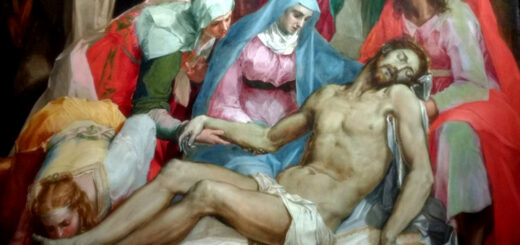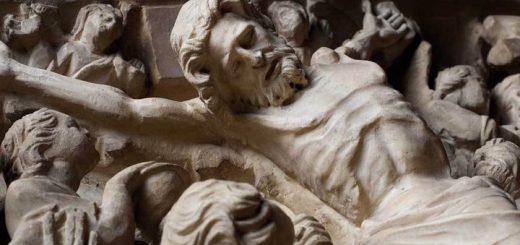So Bellini and Michelangelo revealed the body of Christ
Article by Marco Belpoliti published on La Repubblica on August 20, 2018, pag.28
There are hundreds and hundreds of works, paintings, sculptures, engravings, in which Jesus, both as a child and like Christ on the cross, figure with sex in plain sight. For five centuries, explains Leo Steinberg in The sexuality of Christ (Il Saggiatore, 1986), all these images have been passed in silence. The art historian, born in Russia to a family of Jews - was a member of the Lenin government cabinet from 1917 to 1919 - he scrangled this continent submerged in a series of conferences held in 1981 at Columbia University in New York and published as the special issue of the magazine October In 1983, the most important art magazine of the second half of the twentieth century.
Steinberg, che è morto pochi anni fa novantenne, ha insegnato nelle principali università americane ed è stato il più originale studioso di Picasso, Pollock, Rauschenberg, Warhol e altri artisti del XX secolo. Il suo libro è una incredibile galleria della manifestazione fallica del Figlio di Dio. Per non passare da visionario lo storico ha collezionato ben 123 opere nel volume. Perché questa apparizione del Dio sessuato con la Controriforma sia stata obliata, non è difficile da capire, mentre appare teologicamente più complesso spiegare perché il Bambino divino raffigurato con la Madonna in una incisione di Hans Baldung Grien (1511), mostri un sesso ben visibile, oppure il Cristo risorto di Michelangelo (1514-20) abbia un pene di discrete dimensioni (oggi ricoperto da un pudico manto).
Dopo la fine del Rinascimento cadde un interdetto su quella che era la manifestazione terrena del Figlio di Dio, dotato di organi genitali alla pari di tutti gli uomini. La ragione teologica è semplice: la necessità di rendere il Cristo incarnato fatto di carne e sangue è un atto religioso per quegli artisti, testimonianza della massima impresa compiuta da Dio con il suo Figlio, vero uomo oltre che vero Dio. Se la divinità si è incarnata per subire il destino umano, deve per forza fare propria la condizione di essere sia sessuato che mortale. Attraverso la mortalità di Cristo è assunta anche la sua natura sessuata, parte del progetto divino di redenzione. L’esibizione dell’organo sessuale di Gesù è la prova lampante dell’umanizzazione di Dio.
Sant’Anna indica con il dito il pene del Bambin Gesù appena velato da un panno trasparente in un quadro del Cavalier d’Arpino (1592-93) e nella crocifissione di Hans Schäufelein (1512) il perizoma, che copre il Cristo crocefisso, è legato in modo da manifestare un sesso eretto nel più classico motivo itifallico presente pure in altre pitture del medesimo periodo. Di questi motivi c’è evidente traccia, spiega Steinberg, in una novella del Boccaccio, la decima della terza giornata del Decameron, dove l’eccitazione del romito Rustico è con blasfema ironia definita “resurrezione della carne"After his mortification, a reason that finds himself in the gigantic picture of Sebastiano del Piombo preserved in London to whom Michelangelo collaborated: the thong of Lazzaro shows an evident erection.
Other examples are those of the pictorial depositions, where the deposed body of Christ cried by the disciples and by the Mother often presents the hand resting on the genitals covered by the South. The incarnation of the second person of the Trinity constitutes the pivot of Christian orthodoxy, where its divinity remained hidden so that the devil could not recognize it, hidden even to the most intimate disciples of Christ with the few miracles accomplished. Christian theology developed this terrain aspect of the Messiah until the sixteenth century, separating in a decisive way from the Holy Byzantine icon, where the earthly reason is absent.
The exhibition of images commented by the scholar of Rodin and Jasper Johns - his best book on the twentieth century is entitled Other Criteria (Oxford University Press) — è vasta, con piccoli peni infantili, falli, genitali di varia dimensione e disposizione. In molte opere il sesso di Cristo acquista rilevanza proprio grazie alla mano protettrice della Vergine, con movimenti di grande tenerezza che vanno ben al di là del semplice pudore; la mano di Maria ripara e converte in simbolo la vulnerabile umanità di Cristo come nel dipinto di Giovanni Bellini, Madonna col Bambino (1475-80). Sono soprattutto i quadri della reviviscenza post mortem di Gesù che identificano erezione e resurrezione recuperando motivi precristiani, ad esempio quello di Osiride, il dio egizio dell’oltretomba, che era raffigurato con il membro maschile ricostruito a forma di lancia.
Il quadro di Maerten van Heemskerck, Cristo Dolente (1525-30) esibito in una pagina è connotato dal panno che si erge al centro delle gambe di Gesù coperto di spine, che esprime una sofferenza indicibile, malinconica e triste. C’è poi la questione della circoncisione di Gesù, del sangue di quel rito che ritorna nella memoria visiva del sangue che scende sulla croce e irrora il pube di Gesù.
The view of the dogma, according to an expression that the art historian has deduced from an Italian scholar, is based on a detailed investigation of the predictions and Christian sermons scolded by the Jesuit father John W. O'Malley, whose commentary on Leo Steinberg's conferences, appears in the volume. The religious confirms the theological intuitions of the art historian. The volume ending makes a lot of reflect.
Why have those images disappeared and the artists no longer insisted on Christ's sexuality? Out of shame and modesty? Yes, but the reason is deeper. Stephen Dedalus, Joyce's character, catches him, who indicates the constant physical restraint that keeps fathers and children separate. Christianity had erased this distance in the trinitarian dogma, which indicates the fusion of divine and human, through another very strong image: the hand of the father who rests on the groin of the son.
The oblivion that has fallen on the complex iconography of Christ's sexuality is "The price paid by the modern world for its historic collective abandonment of the mythical foundations of Christianity ". Please reprint Leo Steinberg's book? It is important and unique.






